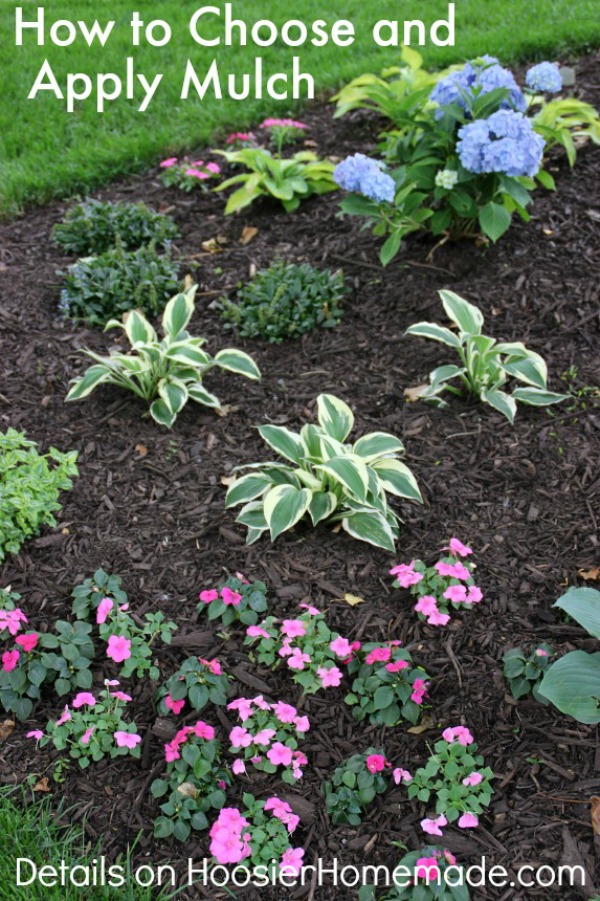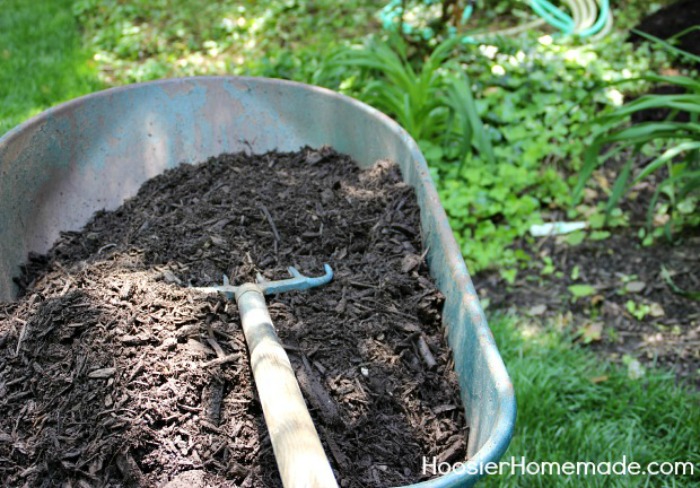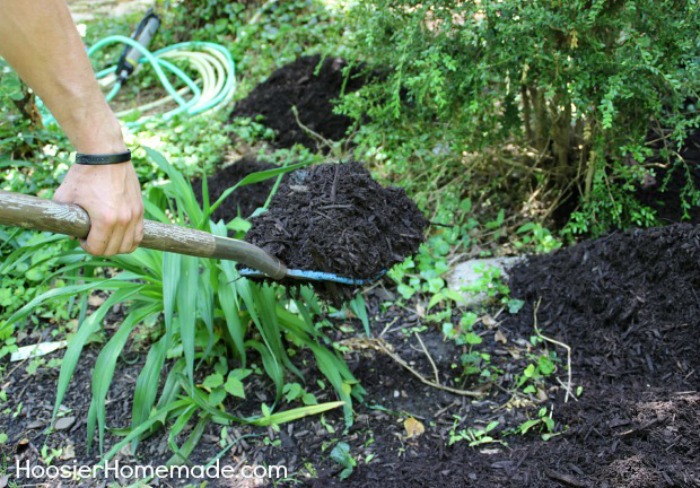How To Choose And Apply Mulch to Your Flower Beds

Knowing how to choose and apply mulch to flower beds is a good habit to get into to preserve the look and health of your landscape and flower beds. But what is mulch? Mulch simply is any material used to cover the soil surface.
Mulching your landscape is inexpensive and is one of the easiest jobs you can do as a homeowner. Mulch helps to moderate soil temperature and retain soil moisture which is good for the health of your plants. Adding a layer of mulch to your flower beds also improves the appearance of your beds and suppresses weed growth. Additionally organic mulches provide nutrients to your plants as they breakdown. Before you start it helps to understand the different types of mulch available, as well as how much mulch to use and when to apply it.
Click here for your FREE garden and landscape journal- the first step to gardening success!
What is Mulch?
Choosing Your Mulch, Organic or Inorganic
Organic and Inorganic. They both have their advantages and best places to be used. Organic mulch consists of shredded wood products which can vary in quality and consistency and comes in a variety of colors. You can also use pine needles, leaf compost and grass clipping for mulch as well. They all have unique characteristics to be aware of, pine needles tend to acidify your soil as they decompose so it is well suited for acidic soils and around plants that prefer acidic soils. Leaf compost adds nutrients to the soil that are readily available to the plants but it tends to blow around if you live in a windy location. Grass clippings are cheap and readily available but they can burn your plants as it decomposes and cause nitrogen deficiency in your plants.
Organic mulches breakdown over time releasing nutrients and enriching the soil. Normally you will need to apply organic mulches every year to maintain the look and benefits they provide to your flower beds.
Inorganic mulch consists of stone products and recycled rubber products. There are many different types of stone to choose from and many people prefer inorganic mulch for this reason alone. They also choose these to reduce problems with insects in and around the flower beds. If you choose to use inorganic mulch be aware that they will radiate heat from the sun and can cause scorching on the lower parts of your plants. There are a couple of ways to address this problem, one is to choose plants that are adapted to this or two, lay organic mulch around the base of the plant and use inorganic mulch in the areas of the flower beds where there are no plants.
Inorganic mulches are more costly initially but do not need to be replenished every year.
How much mulch do you need
All mulches need to be applied 2-4 inches thick. Mulch tends to settle over time as it decomposes so apply an inch more than you want to end up with as a final thickness. Keep in mind that if the mulch is too thin you won’t receive the benefits from using mulch such as retaining moisture and suppressing weed growth.
To determine how many cubic yards of mulch to buy, you’ll need to take a rough measurement of your flower beds in square feet. Multiply the rough size of your flower beds by how deep you want to lay your mulch. Divide this by 324 to find how many cubic yards you need to purchase. For example, if your beds measure 10 foot by 32 foot which equals 320 square feet and you want to put down a 3-inch layer of mulch, you need 3 cubic yards of mulch (320 x 3 = 960 and 960 / 324 = 3).
Bagged mulches are sold based on cubic feet. If you purchase bagged mulch to determine the number of bags you will need to do the following. Convert the depth you intend to apply your mulch from inches to feet by simply dividing by 12, the number of inches in a foot. Now multiply the depth by the area which will give you the cubic feet you need. Then simply divide the cubic feet by the size of the bag you are using. For example, let’s assume we are mulching the same area as we used above. 1o foot by 32 foot to a depth of 3 inches using 2 cubic foot sized bags (3/12 = 0.25) x (10 x 32) =80 cubic feet / 2 cubic foot sized bags = 40 bags needed.
Download our free easy reference guide
When and how to apply mulch
The best time to apply mulch is early spring before your perennials have gotten too much growth on them. This makes it easier and faster to put down the mulch and limits the damage to plants. However you can apply mulch at anytime during the year and many people in cold climate prefer to apply mulch in late fall to protect plants from winter damage such a winter burn and frost heaving.
For tools all you will need are garden gloves to protect your hands, a garden rake to spread the mulch evenly, especially in large open areas and either a scoop shovel or pitchfork for loading your wheelbarrow. Use the wheelbarrow to transport the mulch around your yard whether you are using bulk or bagged.
Spread the mulch evenly either by hand or with your garden rake. Be careful when working around plants, do not step on them and try not to damage the plants with the rake. When applying mulch next to trees, shrubs and woody perennials keep organic mulch 2-3 inches from the base of the plant. To help keep insects out of buildings stay 6 inches away from their foundations.
Controlling weeds in mulch
To help with weed control you have several options available to you. Apply a pre-emergent weed control product like Preen twice a year works well. You can also lay a layer of newspaper 4-6 sheets thick under the mulch or use landscape fabric. The newspaper will decompose and provide some additional nutrients but becomes ineffective in suppressing weeds after a couple of years and landscape fabric can keep organic debris in the mulch and provide an environment for weeds to grow after a few years plus it can make adding or transplanting additional plants troublesome.
Landscaping Questions? Here is a quick reference of information that is very helpful…



I use the dark brown mulch, however within 1 monto it looks much lighter. … Any suggestions to keep it the dark brown color.
Unfortunately, this is very common. One way it to make sure that you put down 3 inches initially then you can refresh the color by lightly raking the surface.
I need a mulch for looks to put over black paper!!! Not for moisture or weeds!!!
I never knew that mulch can suppress any incoming weeds that can grow in your flower beds. My sister just moved into a new home. Hopefully, she can use these tips to create a beautiful area in her yard.
HI everyone! Is it ok to lay down the mulch before you plant the young annual flowers? It seems that one could make a small divot in the mulch, then dig into the soil to a proper depth, plant the flower, tuck the soil back around the flower, and then spread the mulch back around the plant. What do you think? Thank you for any input.
Yes Steven that is perfectly fine. I do that frequently, especially when I’ve applied the mulch early in the Spring before annuals are available for sale. I would suggest that you have some mulch on hand when you plant the annual flowers to touch up around them after they are planted.
Hi love your help . I have just put some bark down not much , on 1 flower bed , but I have a half ton of top soil left over from another flower bed could I put this soil on top of the thin layer of bark
Hi Annette,
I will be fine to spread the soil over the thin layer of mulch.
Doug
Hi thanks for the help I have been mulching for a few years now and the only problem I find is half way through the summer weeds start to actually grow in the mulch am I doing something wrong? Ive even tried starting over with the newspaper but it does the same Help
Hi Janet, as you have noticed weeds are very determined to live. I don’t think you are doing anything wrong. Here are a few suggestions,
1) Apply preen when you lay the mulch, this will provide an additional level of weed control in addition to the mulch.
2) You can increase the thickness of your mulch, I’ve had good luck with a 4 inch layer.
Now if you still have weed escapes even after using these suggestions then my thoughts would be that you are dealing with a perennial weed problem and no amount of mulch will be effective.
Then I would control weed escapes using a non-selective weed killer or by manually removing them.
I love your comments on the mulch.they are very helpful.i saw something in my flowerbeds this year that I have never seen.itooks white and like slim.all thru my flower beds.there were white tuff on my flowers themselves.help
Hi Loretta, Without seeing it, I really can’t say for sure. My best suggestion is to take a sample to your local Extension Office or Garden Center and they should be able to help. I’m guessing it’s mold, but I can’t be sure without seeing it.
Hi, I just found your site through…..Pinterest! Anyway, I was reading your posts about mulch and saw the lovely photos of the front of your home and was drooling. The shade! I know you probably fight it but we are sunbaked here in St. Louis and we have NO trees in the front of our home. I was wondering what that airy vase-shaped tree was in front of your windows. I love the lightness and airiness of it. Thank you.
Hi Karen, thanks so much! We are thrilled you like our home. The tree you asked about is a smoke tree.
~Liz
There are quite a few different wood mulches. Which are the best?
Hi Linda, wood cedar mulch is more resistant to insects around your house. But if you aren’t looking for that look or if it’s not available to you, any hardwood mulch would be our choice. You want to stay away from mulch that is not hardwood.
Hope that helps! Let us know if you have more questions.
I use cardboard as it is thicker than 4-6 pages of newspaper as a weed barrier.
It also last longer yet it does breakdown and allow the nutrients from the mulching breaking down.
Thank you so much, I’m a first time home owner and this will be my first attempt and actually gardening, by cleaning up my front flower bed. I’m assuming if I decide to add new flowers and or bushes, cus my olda seem to be dying. I should put some fresh soil down prior to mulching, and maybe rake out the old multch?
Hi Sara, yes that would be the best option!
Have fun!
~Liz
Thanks for this very informative article! I have never been able to figure mulch correctly, so I always end up spreading it too thin! Self defeating!
So glad it was helpful Mia! Thanks for letting us know!
~Liz
Someone’s math must be off! Your examples were great, except that in the first one you said to multiply the measurements of the flower bed in feet (that was correct), then multiply by 3 (since 3 ft=1 yd) and then divide by 324 to get the cubic YARDS of mulch needed. Then you ended the example by saying that 3 cubic feet of mulch was needed. I knew that was incorrect, because most bags of mulch are sold in bags of 2 cubic feet, and one and a half bags would NOT cover a bed that large! Even if you meant 3 cubic yards, it would not be enough. Did I miss something here or do you still say that 3 cubic feet of mulch is enough for a 320 sq. ft flower bed?
Hey Sandie, Thanks for catching the typo for me! The correct answer is 3 cubic yards not 3 cubic feet. Also the 3 you referenced in your comment [*(since 3 ft=1 yd)] refers to the depth you want to apply the mulch so think of it as 3 inches. So if you wanted to apply your mulch at a depth of 2 inches you would substitute a 2 in the calculation where the 3 is, I hope this clears up the confusion.
Sheww, good to know! Thanks!! 🙂
I usually mulch every year but sometimes can get away with every other year. I need to do it again this year. I don’t know if it’s the mulch I buy, the color or what — but sometimes when I’m adding new mulch, some of the old still laying there has molded and is sometimes clumped together. Is that normal? Our house is covered with shade trees so it doesn’t get alot of sunlight in all areas. Maybe that’s why. Love your dark color mulch too. We usually buy the red color, but I’m liking that dark color!
Hi Jenni, yes molding is normal. We usually just pick up those clumps and toss them.
Happy Gardening!
~Liz
We have something that keeps throwing the mulch out of flower bed and its no squirrels
Hey Linda, Do you have neighborhood dogs and cats that roam free? Sometimes they like to dig in the mulch, especially dogs.
I mulch every year and honestly It’s such an exciting day! It makes everything look so nice. Thanks for the info on how much to buy. I never get it right!
I love how it looks too Ann, so fresh. Glad to help on the amount of mulch.
Happy Gardening!
~Liz